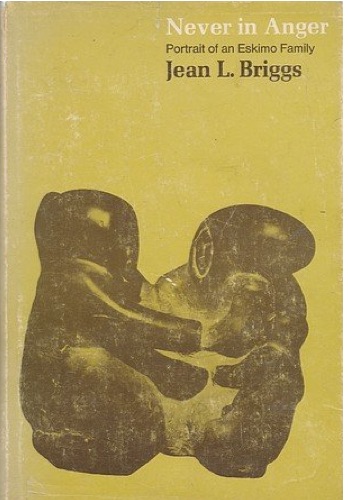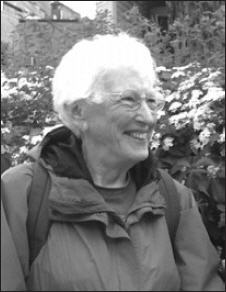

ジーン・L・ブリッグス
Jean L. Briggs, 1929-2016


☆
ジーン・L・ブリッグス(1929年5月28日 -
2016年7月27日)は、アメリカ生まれの人類学者、民族学者、言語学者、ニューファンドランド記念大学名誉教授。彼女の代表作に1970年の画期的な
著書『Never in Anger』がある。 『Never in AngePortrait of an Eskimo
Family(あるエスキモー家族の肖像)』は、1960年代に北極圏沿岸のイヌイット・コミュニティで18ヶ月にわたって行った調査とフィールドワーク
に基づいている[1][2]
| Jean L. Briggs
(May 28, 1929 – July 27, 2016) was an American-born anthropologist,
ethnographer, linguist, and professor emerita at Memorial University of
Newfoundland. Her best known works included the 1970 landmark book
Never in Anger: Portrait of an Eskimo Family, based on 18 months of
research and field work in Inuit communities on the Arctic coast during
the 1960s.[1][2] |
ジー
ン・L・ブリッグス(1929年5月28日 -
2016年7月27日)は、アメリカ生まれの人類学者、民族学者、言語学者、ニューファンドランド記念大学名誉教授。彼女の代表作に1970年の画期的な
著書『Never in Anger』がある。 『Never in AngePortrait of an Eskimo
Family(あるエスキモー家族の肖像)』は、1960年代に北極圏沿岸のイヌイット・コミュニティで18ヶ月にわたって行った調査とフィールドワーク
に基づいている[1][2] |
| Biography Briggs was born in Washington, D.C., on May 28, 1929, the eldest of four children of Margaret (née Worcester) and Horace W. Briggs, member of the clergy of The New Church, also known as Swedenborgianism.[1] She was raised in the state of Maine and Newton, Massachusetts.[2] Jean Briggs received her bachelor's degree from Vassar College in 1951.[1] She then completed a master's degree from Boston University in 1960 and her Ph.D. from Harvard University in 1967.[1][3] In 1967, Briggs moved to the Canadian province of Newfoundland and Labrador and joined the Department of Anthropology at Memorial University in St. John's, where she taught for 47 years.[1][2] She was a student of Cora Du Bois, an American cultural and psychiatric anthropologist.[2] In 1970, she published her best-known book, Never in Anger: Portrait of an Eskimo Family, based on research conducted while living with an Inuit family along the Chantrey Inlet for 18-months during the 1960s.[1] She documents the culture, language and practices of the family and the surrounding community in the book, which remains a landmark publication in the fields of ethnography and anthropology.[1][2] By her own account, Briggs knew very few Inuit words when she arrived to conduct her research, "When I arrived in Chantrey Inlet in 1963, I knew only six words of Inuktitut: 'yes,' 'no,' ‘I don’t know,’ ‘have some tea,’ 'have some more tea' and 'thank you'."[2] In 1988, Briggs published a second book, Inuit Morality Play: The Emotional Education of a Three-Year-Old. Her book won two awards, the Boyer Prize from the Society for Psychoanalytic Anthropology and the Victor Turner Prize from the Society for Humanistic Anthropology.[1][3] Jean Briggs compiled a landmark, bilingual Utkuhiksalingmiut Inuktitut dictionary, which was published in 2015.[1][2] Briggs had begun compiling Utkuhiksalingmiut Inuktitut words in 1970, ultimately gathering and preserving 3 4,000 words in the dictionary.[2] Prior to its 2015 publication, no dictionary had ever documented the Utkuhiksalingmiut Inuktitut dialect.[1][3][2] Several researches and colleagues from Memorial University and the University of Toronto joined her to create the dictionary, utilizing five grants from the Social Sciences and Humanities Research Council (SSHRC).[2] Most of her fieldwork and research focused on the Canadian Inuit, but she also visited communities of Alaskan Inupiat and Siberian Yupik people.[2] Jean Briggs died from congestive heart failure on July 27, 2016, at the age of 87.[1][2] |
略歴 ブリッグスは1929年5月28日、ワシントンDCに生まれた、 1929年5月28日、スウェーデンボルジア派として知られる新教会の聖職者であるマーガレット(旧姓ウスター)とホレス・W・ブリッグスの4人兄弟の長女として生まれた[1]。 1967年、ブリッグスはカナダのニューファンドランド・ラブラドール州に移り、セントジョンズにあるメモリアル大学の人類学科に入り、そこで47年間教鞭をとった[1][2]。 1970年、彼女は最も有名な著書『Never in Anger』を出版した: この本は、1960年代に1年半にわたってシャントレー入り江沿いのイヌイットの家族と暮らしたときの調査に基づいている。彼女はこの本の中で、その家族 と周囲のコミュニティの文化、言語、慣習を記録しており、民族学と人類学の分野において画期的な出版物となっている。1963年にシャントレー・インレッ トに到着したとき、私はイヌクティトゥット語の単語を6つしか知らなかった: はい」、「いいえ」、「わかりません」、「お茶をどうぞ」、「もっとお茶をどうぞ」、そして「ありがとう」。 1988年、ブリッグスは2冊目の本『イヌイットの道徳遊び:3歳児の情操教育』を出版した。彼女の著書は、精神分析人類学会のボイヤー賞と人間性人類学会のヴィクター・ターナー賞という2つの賞を受賞した[1][3]。 ジャン・ブリッグスは画期的なウトゥクヒクサリンミウト・イヌクティトゥット語の対訳辞書を編纂し、2015年に出版された[1][2]。ブリッグスは 1970年にウトゥクヒクサリンミウト・イヌクティトゥット語の編纂を始め、最終的に34,000語をこの辞書に集め、保存していた。 [2]2015年に出版されるまで、ウトゥクヒクサリンミウト・イヌクティトゥット方言を記録した辞書は存在しなかった[1][3][2]。社会科学・人 文科学研究評議会(SSHRC)の5つの助成金を活用し、メモリアル大学とトロント大学の複数の研究者や同僚が辞書作成に参加した[2]。 彼女のフィールドワークと研究のほとんどはカナダのイヌイットに焦点を当てたものであったが、アラスカのイヌピアットやシベリアのユピックの人々のコミュニティも訪問した[2]。 ジーン・ブリッグスは2016年7月27日、うっ血性心不全のため87歳で死去した[1][2]。 |
| Honors and awards Briggs won the Lifetime Achievement Award from the Society for Psychological Anthropology,[4] as well as an honorary doctorate from the University of Bergen in Norway.[2] She was also a Royal Society of Canada fellow.[1] |
栄誉と賞 ブリッグスは、心理人類学会から生涯功労賞を受賞し[4]、ノルウェーのベルゲン大学から名誉博士号を授与された[2]。 また、カナダ王立協会のフェローでもある[1]。 |
| https://en.wikipedia.org/wiki/Jean_Briggs |
|
| Jean Briggs
was born in the United States on May 28, 1929. She told (Michael) Conor
Cook and me that this day coincides with the blooming of bridal wreath
or Spiraea, which is certainly the case in Toronto every year. I first
met Jean when I taught linguistics at Memorial University of
Newfoundland, where she was Henrietta Harvey Professor and then later
Professor Emerita after teaching anthropology there for over four
decades. She was a bit intimidating. No general light talk but probing
questions and an expectation that detail and accuracy be central.
Later, when I was teaching at the University of Toronto, she asked me
to be co-investigator on her Social Sciences and Humanities Research
Council of Canada (SSHRC) project to make a dictionary based on the
extensive tapes and notes she made during her work with the
Utkuhiksalingmiut. These Inuit originated from the Utkuhiksalik region
in Nunavut and later moved into settled communities. We started the
work in 2000, when we received our first SSHRC grant. Jean received her PhD in anthropology from Harvard University in 1967. Her thesis supervisor was Cora Du Bois, the second woman ever tenured in the Faculty of Arts and Science at Harvard. When I think of it, Jean’s crusty nature may have been due not solely to growing up in New England, but also to having become a highly successful female academic in those days. Cora Du Bois introduced the techniques and perspectives of psychology into anthropology. Jean’s research centred on patterns of emotion within Inuit culture, e.g., absence of overt anger or “the psychodynamic underpinnings of Inuit culture” as manifested through the play of one child (Briggs 1998, 2). Her approach was subjective; she did not describe things categorically as an outside observer, but instead developed ideas within the context of her own social interactions and observations of details. In 2005 she earned the Lifetime Teaching Award from the Society for Psychological Anthropology. Jean received many other honours to acknowledge her contributions, including being made a fellow of the Royal Society of Canada in 2001 and being awarded an honorary doctorate by the University of Bergen in 1996. Her most famous work is the book Never in Anger. I read it while visiting an Inuit community and learning firsthand about the more indirect nature of interpersonal disagreements. Jean had a special interest in the socialization of small children, which led to her book Inuit Morality Play: The Emotional Education of a Three-Year-Old, which won the 1999 Boyer Prize from the Society for Psychoanalytic Anthropology and was also co-winner of the 1999 Victor Turner Prize from the Society for Humanistic Anthropology. Jean’s research in anthropology and linguistics was primarily based on two locations she visited. One involved extended visits in the mid-1960s to Chantrey Inlet in the Utkuhiksalik region near the mouth of the Back River. The other visits were to a hunting camp in North Baffin near Pangnirtung. Jean resided in these camps at a time when groups of Inuit lived solely on the land, and in later years when they moved into settlements. As I became familiar with her exacting and assiduous methodology, I often thought about the Inuit in the camps on the land where she stayed for lengthy periods. She was not only a Qablunaaq (Caucasian) but also a female Qablunaaq, and one who had little truck for traditional female roles, even in her own society. I think she engaged people intellectually (as she did the rest of us). She learned to speak Utkuhiksalingmiutut by immersion, and subsequently by asking questions in the language, frequently metalinguistic in nature. Her Inuit interlocutors were up to the challenge and ready to consider and discuss with her abstract matters of contextual meaning, grammatical variations, and dialect. Her main colleagues in this type of endeavour were members of the Utkuhiksalingmiut family who had adopted her and other members of the Utkuhiksalingmiut community. These included Rosie Kigiak and her family, Simon Tookoome, and Joedee Joedee. Jean kept copious notes and well-organized audiotapes. After retirement, Jean continued with her research, especially the language materials. She lived modestly in her beloved Maddox Cove on the edge of the Atlantic Ocean. I remember asking after visiting her first house there—which was quite close to the edge of a cliff overlooking the churning, frigid Atlantic waters—if she worried about falling off. Her reply was simply that she wore crampons on her boots in the winter when it was icy. Although Jean referred to herself frequently as a technological dinosaur, it was she who insisted that our dictionary team devise a long-distance work technique. We had learned from Marguerite MacKenzie that group editing is much more efficient while looking at a common projector screen. Jean maintained that we could (and must) work jointly in this fashion online, because an Italian friend of hers worked on translation documents this way. Not knowing the friend or the details, I had to find and learn how to use online meeting software (WebEx). Screen sharing in the mid-2000s was truly a miracle. Conor could be in Santiago, Chile, Jean in St. John’s, and me in Toronto, but we felt as if we were sitting together in the same room, barring local broadband and hearing issues. Jean’s corporal and mental faculties were strong to just before the end of her life. In February 2012, when she was eighty-two years old, she and Conor visited Gjoa Haven to consult with the community about the writing systems we were hoping to use for the dictionary. We published Utkuhiksalingmiut Uqauhiitigut: Dictionary of Utkuhiksalingmiut Inuktitut Postbase Suffixes in 2015, but did not get to finish the “Big Dictionary,” a dictionary of regular words. Jean’s incisive perceptions, as well as those of her Utkuhiksalingmiut mentors and collaborators inform the postbase dictionary in every respect. She and Conor worked together closely, and Jean highly valued Conor’s vital contribution. It was Jean’s decision not to have the book published by a more academically prestigious press. She wanted to make it available across the North at an affordable price to Inuit. We were very happy with the quality of publication by Nunavut Arctic College. One event that pleased Jean immensely was the opportunity to communicate some of her thoughts through the CBC radio show Ideas.[1] Her memory was honoured by a special panel session at the Annual Meeting of the American Anthropological Association (AAA) in Washington, DC, in late 2017. Remembered with fondness for all of the many facets of her personality and admired for the quality and depth of her research, Jean Briggs’s legacy will provide many with one person’s snapshot of a time now gone but viewed with an abundance of analytical detail. Note [1]The resulting two episodes, “Never in Anger and Beyond: Parts 1 and 2, can be found at http://www.cbc.ca/player/play/2263114454 and http://www.cbc.ca/player/play/2263120301. Appendices References BRIGGS, Jean L. , 1970 Never in Anger: Portrait of an Eskimo Family. Cambridge, MA: Harvard University Press. Google Scholar BRIGGS, Jean L. , 1998 Inuit Morality Play: The Emotional Education of a Three-Year-Old. St John: St. John’s Institute of Social and Economic Research; New Haven, CT: Yale University Press. Google Scholar BRIGGS, Jean, Alana JOHNS, and Michael Conor COOK, 2015 Utkuhiksalingmiut Uqauhiitigut: Dictionary of Utkuhiksalingmiut Inuktitut Postbase Suffixes. Iqaluit: Nunavut Arctic College. Google Scholar |
ジー
ン・ブリッグスは1929年5月28日にアメリカで生まれた。彼女は(マイケル・)コナー・クックと私に、この日はブライダル・リース(Spiraea)
の開花と重なると話してくれた。私がジーンに初めて会ったのは、彼女がヘンリエッタ・ハーヴェイ教授を務め、その後40年以上にわたって人類学を教えてい
たニューファンドランド記念大学で言語学を教えていたときだった。彼女は少し威圧的だった。一般的な軽口は言わず、突っ込んだ質問をし、詳細と正確さが中
心であることを期待した。その後、私がトロント大学で教えていたとき、彼女はカナダ社会科学・人文科学研究評議会(SSHRC)のプロジェクトで、ウトゥ
クヒクサリングミウトとの共同研究の際に作成した膨大なテープとメモをもとに辞書を作る共同研究者を私に依頼した。このイヌイットはヌナブトのウトゥクヒ
クサリック地方出身で、後に定住コミュニティに移った。私たちは2000年、SSHRCから最初の助成金を得てこの研究を開始した。 ジーンは1967年にハーバード大学で人類学の博士号を取得。学位論文の指導教官は、ハーバード大学文理学部で女性として2人目の終身在職者となったコー ラ・デュボワだった。考えてみれば、ジーンの気難しさは、ニューイングランドで育ったことだけでなく、当時、女性学者として大成功を収めたことにも起因し ていたのかもしれない。コーラ・デュボアは人類学に心理学の技法と視点を導入した。ジーンの研究の中心は、イヌイット文化における感情のパターン、たとえ ば、あからさまな怒りの不在や、ある子どもの遊びを通して現れた「イヌイット文化の精神力動的基盤」であった(Briggs 1998, 2)。彼女のアプローチは主観的で、外部の観察者として物事を断定的に記述するのではなく、彼女自身の社会的相互作用や細部の観察の文脈の中で考えを発展 させていった。2005年、彼女は心理人類学会から生涯教育賞を受賞した。その他、2001年にカナダ王立協会フェロー、1996年にベルゲン大学から名 誉博士号を授与されるなど、彼女の貢献を称える多くの栄誉を受けている。彼女の最も有名な著作は『Never in Anger』である。私はこの本を、イヌイットのコミュニティを訪れながら読み、対人関係の不和がより間接的なものであることを身をもって学んだ。ジーン は小さな子どもの社会化に特別な関心を持っており、それが彼女の著書『イヌイットの道徳遊び:3歳児の感情教育』につながった。この本は1999年に精神 分析人類学会のボイヤー賞を受賞し、1999年には人間性人類学会のビクター・ターナー賞も共同受賞した。 ジーンの人類学と言語学の研究は、主に彼女が訪れた2つの場所に基づいている。ひとつは1960年代半ば、バック・リバー河口近くのウトゥクヒクサリク地 域のチャントリー・インレットを長期にわたって訪れたこと。もうひとつは、ノース・バフィンのパングナートング近くの狩猟キャンプである。ジーンは、イヌ イットの集団が土地だけで生活していた時代と、その後彼らが集落に移り住んだ時代に、これらのキャンプに住んでいた。彼女の厳格で几帳面な方法論に親しむ につれ、私は彼女が長期滞在した土地のキャンプにいたイヌイットのことをよく考えるようになった。彼女はカブルナーク(白人)であるだけでなく、女性のカ ブルナークであり、彼女自身の社会でさえ、伝統的な女性の役割に対してほとんどトラックを持っていなかった。彼女は(私たちがそうであったように)知的に 人々と関わっていたと思う。彼女はウトゥクヒクサリンミウト語に没頭することで、ウトゥクヒクサリンミウト語を話せるようになり、その後ウトゥクヒクサリ ンミウト語で質問することで、しばしばメタ言語的な性質を持つウトゥクヒクサリンミウト語を習得した。彼女のイヌイット語仲間は、文脈上の意味、文法上の 変化、方言といった抽象的な事柄について、彼女と一緒に考え、議論する準備ができていた。このような努力における彼女の主な同僚は、彼女を養子に迎えたウ トゥクヒクサリングミウトの家族のメンバーや、ウトゥクヒクサリングミウト・コミュニティの他のメンバーだった。ロージー・キギアックとその家族、サイモ ン・トゥークーム、ジョエディー・ジョエディーなどである。ジーンは膨大なメモと整理された録音テープを保管していた。 引退後もジーンは研究を続け、特に言語資料の作成に力を注いだ。彼女は大西洋の端にある愛着のあるマドックス・コーブで慎ましく暮らしていた。彼女の最初 の家を訪ねた後、その家は大西洋の冷たい海を見下ろす崖の端に近かったので、落ちないか心配だったかと尋ねたことを覚えている。彼女の答えは、氷の張る冬 にはブーツにアイゼンをつける、というものだった。 ジーンは自分のことを技術的な恐竜だと言っていたが、私たちの辞書チームに長距離作業のテクニックを考案するよう主張したのは彼女だった。私たちはマルグ リット・マッケンジーから、共通のプロジェクター画面を見ながらのグループ編集がはるかに効率的であることを学んでいた。ジャンは、彼女のイタリア人の友 人がこの方法で翻訳文書に取り組んでいたことから、私たちはオンラインでこの方法で共同作業ができる(しなければならない)と主張した。その友人も詳細も 知らない私は、オンライン会議ソフト(WebEx)を探して使い方を学ばなければならなかった。2000年代半ばの画面共有はまさに奇跡だった。コナーは チリのサンティアゴに、ジャンはセントジョンズに、私はトロントにいることができたが、地域のブロードバンドや聴力の問題を除けば、同じ部屋に一緒に座っ ているような感覚だった。ジーンの身体的、精神的能力は、最期を迎える直前まで強かった。2012年2月、彼女が82歳のとき、コナーとともにグジョア・ ヘイブンを訪れ、私たちが辞書に使いたいと考えている文字体系についてコミュニティと相談した。私たちは『Utkuhiksalingmiut Uqauhiitigut』を出版した: 2015年に『Utkuhiksalingmiut Inuktitut Postbase Suffixes Dictionary of Utkuhiksalingmiut』を出版しましたが、通常の単語の辞書である『Big Dictionary』を完成させることはできませんでした。ジーンの鋭い洞察力、そしてウトゥクヒクサリングミウト語の指導者たちや協力者たちの洞察力 は、あらゆる点でこのポストベース辞書に活かされている。彼女とコナーは密接に協力し合い、ジーンはコナーの重要な貢献を高く評価した。学術的に権威のあ る出版社からこの本を出版しないことは、ジーンの決断だった。彼女は、イヌイットが手ごろな価格で北部全域で入手できるようにしたかったのだ。ヌナブト・ アークティック・カレッジが出版した本のクオリティにはとても満足しています」。ジーンを非常に喜ばせた出来事のひとつは、CBCのラジオ番組「アイデ ア」を通じて、彼女の考えの一部を伝える機会を得たことである[1]。2017年末にワシントンDCで開催されたアメリカ人類学会(AAA)の年次総会で は、彼女の思い出を称える特別パネルセッションが行われた。ジーン・ブリッグスの遺産は、今は亡き時代の一個人のスナップショットを、豊富な分析的詳細と ともに多くの人々に提供するだろう。 |
| https://www.erudit.org/en/journals/etudinuit/2017-v41-n1-2-etudinuit04714/1061444ar/ |
|
リ ンク
文 献
そ の他の情報
Copyleft, CC, Mitzub'ixi Quq Chi'j, 1996-2099
☆
 ☆
☆